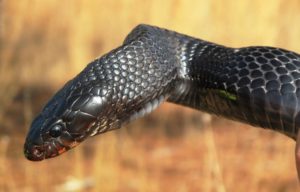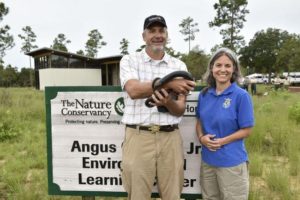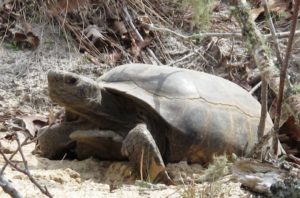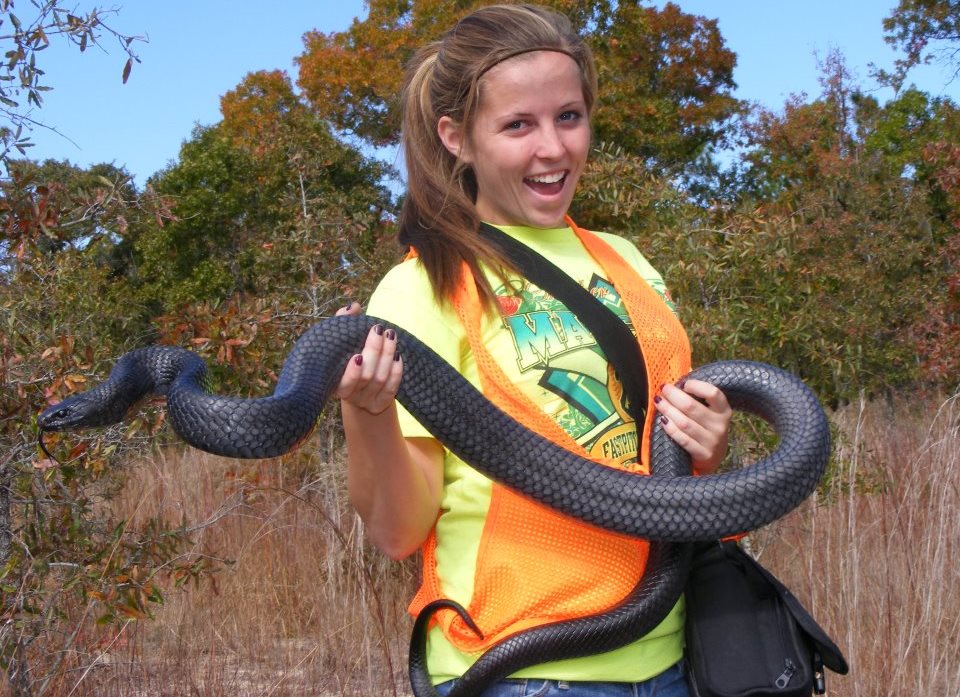The federally-threatened eastern indigo (Drymarchon couperi) is a large, nonvenomous colubrid snake. It’s an icon of the southern longleaf pine forest, native primarily to Florida and Georgia.
 With the largest recorded specimen being over 9 feet, and weighing about 10 pounds, it’s the longest native snake species in the U.S. Not the heaviest though: that honor goes to the eastern diamondback rattlesnake, the largest specimen of which was 7.8 feet long, but weighing 34 pounds.
With the largest recorded specimen being over 9 feet, and weighing about 10 pounds, it’s the longest native snake species in the U.S. Not the heaviest though: that honor goes to the eastern diamondback rattlesnake, the largest specimen of which was 7.8 feet long, but weighing 34 pounds.
Easrtern indigos are also one of the rarest snakes in North America, thanks to a perfect storm of sprawl development, unsustainable agricultural practices, excessive roads, and the illegal snake trade.
But restoration is underway. A reintroduction of captive-bred indigo snakes took place on July 17, 2017 at The Nature Conservancy‘s Apalachicola Bluffs and Ravines Preserve ABRP).
The release of 12 indigo snakes, the first of many planned releases, is a key step towards the species’ recovery in the region. “The eastern indigo snake has been listed as threatened under the Endangered Species Act since 1978, and today’s release is an important milestone in our efforts toward recovering this important reptile,” said Cindy Dohner, regional director for the U.S. Fish and Wildlife Service’s Southeast region.

David Printiss of TNC & Michele Elmore, of USFWS prepare to release one of 12 indigo snakes. Photo by Tim Donovan, FWC.
“Conservation work like this requires many partners like those here today, and the efforts of everyone today will help ensure that future generations can see this beautiful snake in the wild,” she continued. “It marks an important step in our collective effort to recover the indigo snake and ultimately remove it from the list of protected wildlife,” she continued.
In addition to The Nature Conservancy and the Service, partners in the long-term conservation effort for the eastern indigo include Central Florida Zoo’s Orianne Center for Indigo Conservation (OCIC), Auburn University, the Florida Fish and Wildlife Conservation Commission, The Orianne Society, Joseph W. Jones Ecological Research Center, Gulf Power, Southern Company (through the National Fish and Wildlife Foundation), and the Fish and Wildlife Foundation.
Largely eliminated from northern Florida due to habitat loss and fragmentation, the indigo was last observed at ABRP in 1982.
The indigo forages on a variety of small animals, including both venomous and non-venomous snakes, and serves a critical function as an apex predator that is important for a healthy and balanced wildlife community. In fact, just days after this release, one of the indigos was observed eating a venomous copperhead snake.
The reintroduction begins a 10-year commitment to species recovery through annual indigo releases, and continues a focus on establishment of healthy ecosystems through collaborative land, water, and wildlife conservation efforts.
“Today’s eastern indigo snake reintroduction at the Conservancy’s Apalachicola Bluffs and Ravines Preserve is a testament to the decades-long effort by Conservancy staff, and the teamwork of an incredible group of partners in the implementation of innovative restoration methods that resulted in healthy, restored longleaf pine landscape,” said Temperince Morgan, executive director, The Nature Conservancy in Florida.
ABRP is a 6,295-acre nature preserve in northern Florida’s Liberty County which protects a large longleaf pine landscape and embedded steephead ravines and streams. Located in the Apalachicola Bay region along the Apalachicola River, the preserve lies in the center of one of five biological hotspots in North America. This treasure trove of species diversity is unique to Florida and home to a disproportionate number of imperiled species. The preserve is a living laboratory for the development of novel restoration techniques and land management excellence, dedicated to natural community restoration, preservation of biodiversity, and education and training.
Bred and raised by the OCIC, the 12 young snakes released (eight males and four females) have most recently been living in outdoor enclosures that allow them to be exposed to natural environment they would encounter in the wild, in preparation for their release. The snakes have been implanted with radio transmitters for tracking and monitoring.
“The indigo snake reintroduction effort in Florida is one of the greatest partnership-driven conservation stories of modern times,” said Chris Jenkins, chief executive officer of The Orianne Society. “Not only is it a considerable accomplishment to bring a group together that can make the reintroduction of wildlife possible, it is an especially significant show of support for an imperiled species of snake.”
Eastern indigo snakes frequent flatwoods, hammocks, dry glades, stream bottoms, cane fields, riparian thickets, and high ground with well-drained, sandy soils in Florida and Georgia. In Georgia, eastern indigo snakes prefer excessively drained, deep sandy soils along major streams, as well as xeric sandridge habitats. Xeric (arid) slash pine plantations seem to be preferred over undisturbed longleaf pine habitats.
 When I (Storm) lived in Florida, indigos were most often found in gopher tortoise burrows. But virtually-unregulated sprawl has destroyed almost all of these upland habitats, and unethical snake hunters often spray gasoline down gopher tortoise burrows to flush the indigos out.
When I (Storm) lived in Florida, indigos were most often found in gopher tortoise burrows. But virtually-unregulated sprawl has destroyed almost all of these upland habitats, and unethical snake hunters often spray gasoline down gopher tortoise burrows to flush the indigos out.
Despite (or because of) their protected status, indigos are prized in the illegal pet trade. As a lifelong “herper”, one of my greatest thrills was briefly holding a captive-bred 8-foot specimen of one of these gorgeous animals. I’ve held snakes twice as long and ten times heavier, but there’s something very unique about both the personality and the feel of the eastern indigos.
Feature photo of Orianne Society volunteer by Mark Wallace.
Unless otherwise credited, all other photos courtesy of Andrew Durso.

